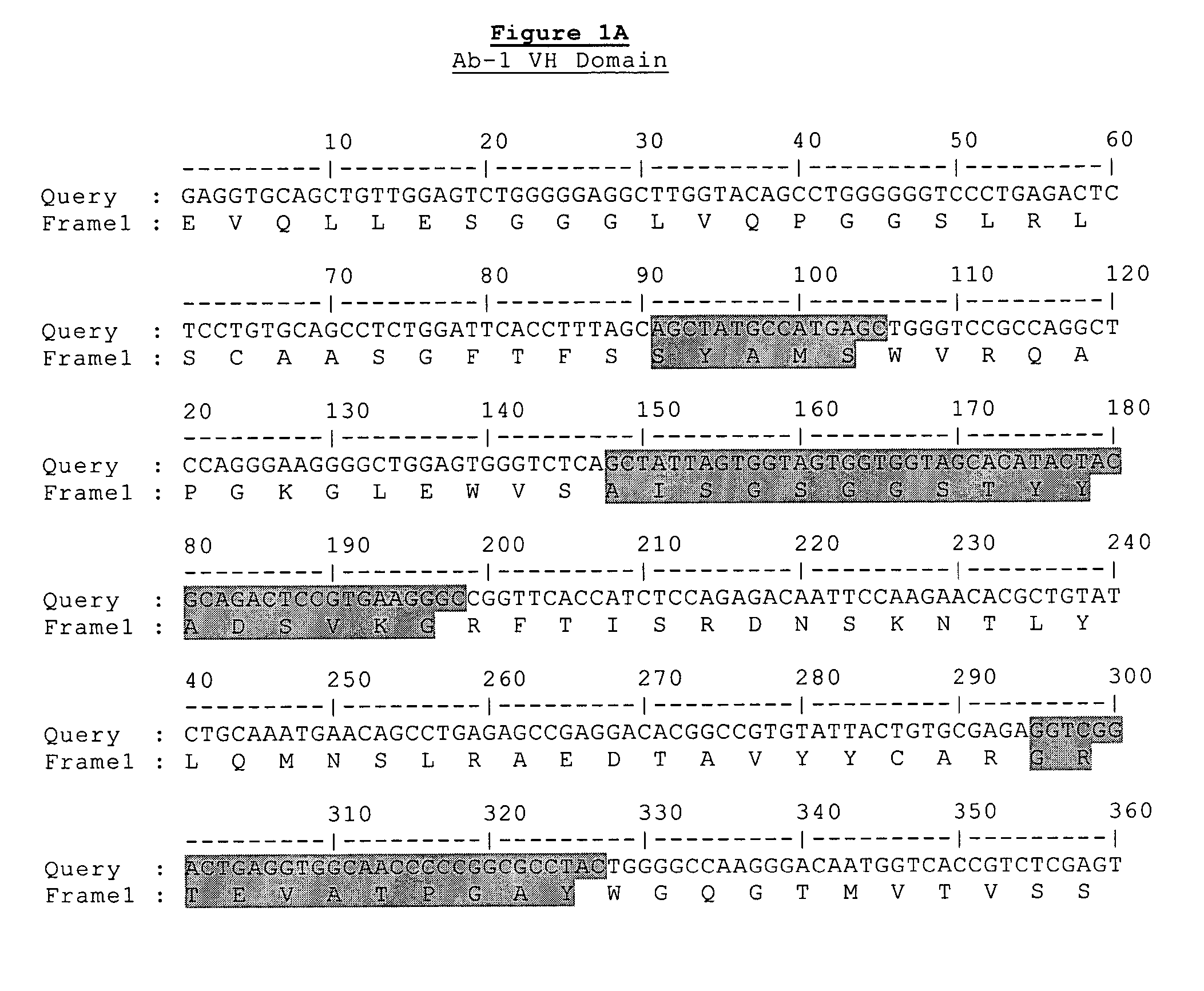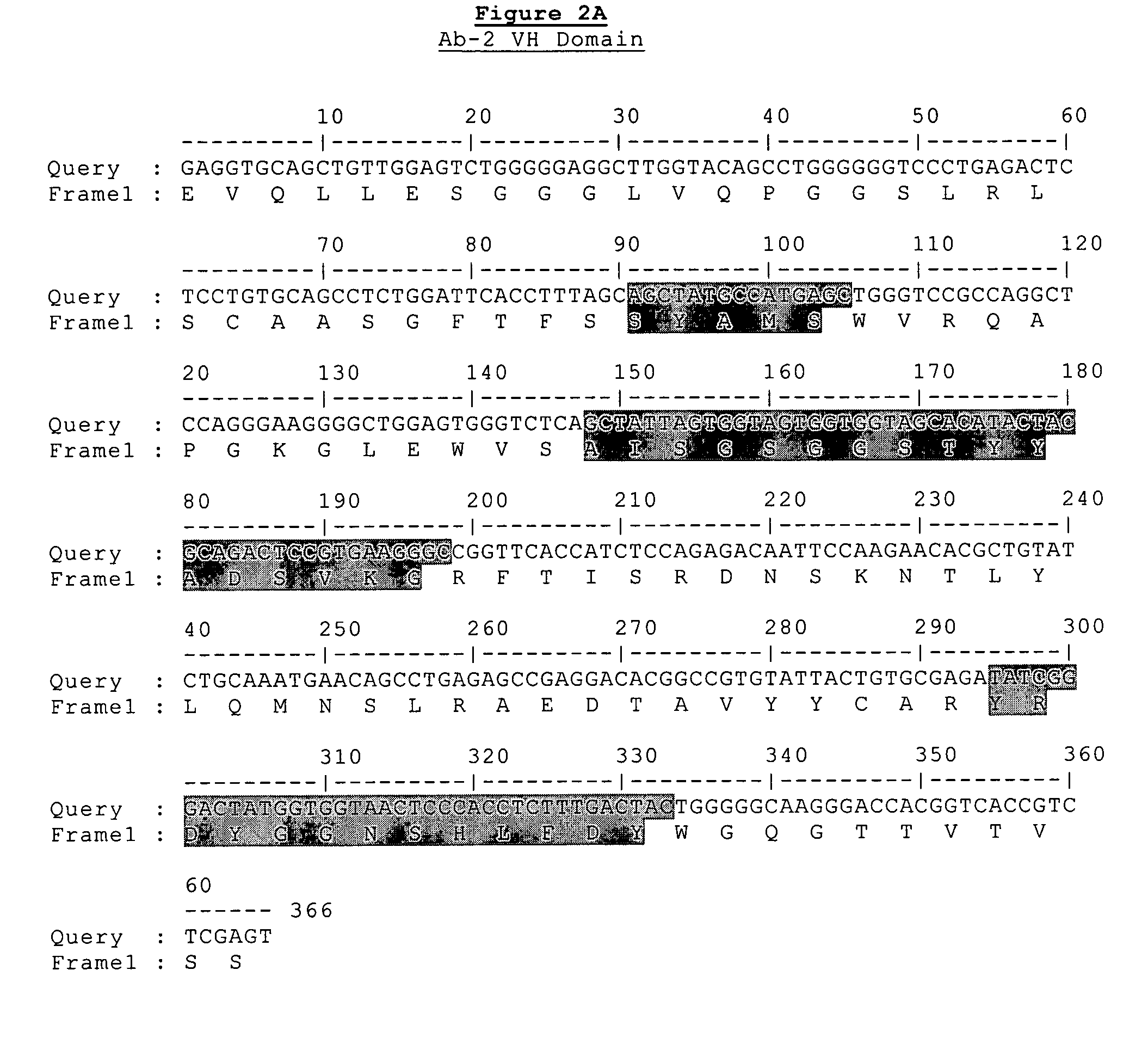Antibodies of angiogenesis inhibiting domains CD148
an angiogenesis and anti-domain technology, applied in the field of anti-cd148 antibodies, can solve problems such as process go awry
- Summary
- Abstract
- Description
- Claims
- Application Information
AI Technical Summary
Problems solved by technology
Method used
Image
Examples
example 1
Generation of Antibodies Against CD148 Epitopes
[0314]Parental versions of the heavy and light chains regions of the antibodies of the present invention were identified using the following screening procedure. Recombinant scFv (single chain variable fragment) phage display libraries from Cambridge Antibody Technologies (CAT) were interrogated in vitro against huCD148 protein targets. Over 10,000 clones were screened, recovered by phage display (2nd and 3rd round outputs) and greater than 250 unique scFv antibodies were identified that specifically bind huCD148. Of these reagents, 83 were consolidated for further study, based upon their predicted therapeutic potential. For example, several antibodies were isolated that compete for binding to the same epitope as that of N24 as measured by competitive ELISA or TRF (time-resolved fluorescence) report. Other antibodies were consolidated based upon their relatively high signal-to-noise ratio as indicated by ELISA or TRF (e.g., target bindi...
example 2
Mapping of CD148 Binding Epitopes
[0323]Synthetic peptide 15-mers corresponding to the ectodomain of human CD148 primary protein sequence were synthesized and covalently N-linked to sectors on PVDF membranes. The composition of the various peptide sequences overlapped by 3 amino acids.
[0324]Peptide-containing membranes were preincubated with MeOH for 10 min, washed 3 times with PBST and incubated overnight with 4% milk in PBST. After 3 washes with PBST the membrane was incubated for 3 hours with 1 μM anti-CD148 antibody diluted in 4% milk. The membrane was washed again 3 times and then incubated for 1 hr with either anti-human Fc-HRP or anti-mouse Fc-HRP (Jackson). After 3 washes with PBST binding was detected using the Super Signal kit from Pierce.
[0325]Peptide-containing membranes were regenerated for new experiments by immediately washing them twice with water (after one use) and then incubating them overnight with DMF. After 2 washes with water the membrane was washed with regene...
example 3
Construction and Assay of FLAG, Poly-Histidine and Fc fusion Proteins
[0330]The following constructs were subcloned into the p412 mammalian expression vector flanked N-terminally by both an IgK leader sequence and Flag poly-Histidine tag fusions; huCD148-ECTO (residues 36-973); huCD148-NFnIII (residues 36-210); huCD148-FnII2—3 (residues 175-536); huCD148-FnIII4—5 (residues 533-725); huCD148-Cterm: (residues 715-973). These clones were transiently transfected into COS PKB (E5) cells and purified using an IMAC column.
[0331]The binding of different anti-CD148 antibodies was tested using 2 different ELISA methods. The first method is a direct ELISA on Ni-NTA plates. Ni-NTA plates (Invitrogen) were coated with 4 dilutions (1:10-1:10.000) of the 5 proteins in 3% BSA in PBS and were incubating overnight at 4° C. The plates were washed with PBST and incubated with 1 μg / ml of Ab-2-huIgG4, Ab-5-huIgG4, the murine anti-CD148 antibody, and 143-41 (Biosource) for 2 hrs at room temperature. After ...
PUM
| Property | Measurement | Unit |
|---|---|---|
| concentration | aaaaa | aaaaa |
| diameter | aaaaa | aaaaa |
| dissociation constant | aaaaa | aaaaa |
Abstract
Description
Claims
Application Information
 Login to View More
Login to View More - R&D Engineer
- R&D Manager
- IP Professional
- Industry Leading Data Capabilities
- Powerful AI technology
- Patent DNA Extraction
Browse by: Latest US Patents, China's latest patents, Technical Efficacy Thesaurus, Application Domain, Technology Topic, Popular Technical Reports.
© 2024 PatSnap. All rights reserved.Legal|Privacy policy|Modern Slavery Act Transparency Statement|Sitemap|About US| Contact US: help@patsnap.com










